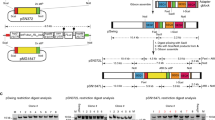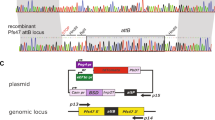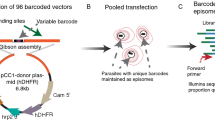Abstract
Malaria afflicts over 200 million people worldwide, and its most lethal etiologic agent, Plasmodium falciparum, is evolving to resist even the latest-generation therapeutics. Efficient tools for genome-directed investigations of P. falciparum-induced pathogenesis, including drug-resistance mechanisms, are clearly required. Here we report rapid and targeted genetic engineering of this parasite using zinc-finger nucleases (ZFNs) that produce a double-strand break in a user-defined locus and trigger homology-directed repair. Targeting an integrated egfp locus, we obtained gene-deletion parasites with unprecedented speed (2 weeks), both with and without direct selection. ZFNs engineered against the parasite gene pfcrt, responsible for escape under chloroquine treatment, rapidly produced parasites that carried either an allelic replacement or a panel of specified point mutations. This method will enable a diverse array of genome-editing approaches to interrogate this human pathogen.
This is a preview of subscription content, access via your institution
Access options
Subscribe to this journal
Receive 12 print issues and online access
$259.00 per year
only $21.58 per issue
Buy this article
- Purchase on Springer Link
- Instant access to full article PDF
Prices may be subject to local taxes which are calculated during checkout




Similar content being viewed by others
References
Dondorp, A.M. et al. The threat of artemisinin-resistant malaria. N. Engl. J. Med. 365, 1073–1075 (2011).
Meissner, M., Breinich, M.S., Gilson, P.R. & Crabb, B.S. Molecular genetic tools in Toxoplasma and Plasmodium: achievements and future needs. Curr. Opin. Microbiol. 10, 349–356 (2007).
Anderson, T., Nkhoma, S., Ecker, A. & Fidock, D. How can we identify parasite genes that underlie antimalarial drug resistance? Pharmacogenomics 12, 59–85 (2011).
Bibikova, M., Golic, M., Golic, K.G. & Carroll, D. Targeted chromosomal cleavage and mutagenesis in Drosophila using zinc-finger nucleases. Genetics 161, 1169–1175 (2002).
Carroll, D. Genome engineering with zinc-finger nucleases. Genetics 188, 773–782 (2011).
Miller, J.C. et al. An improved zinc-finger nuclease architecture for highly specific genome editing. Nat. Biotechnol. 25, 778–785 (2007).
Doyon, Y. et al. Enhancing zinc-finger-nuclease activity with improved obligate heterodimeric architectures. Nat. Methods 8, 74–79 (2011).
Urnov, F.D. et al. Genome editing with engineered zinc finger nucleases. Nat. Rev. Genet. 11, 636–646 (2010).
Gardner, M.J. et al. Genome sequence of the human malaria parasite Plasmodium falciparum. Nature 419, 498–511 (2002).
Mimitou, E.P. & Symington, L.S. DNA end resection: many nucleases make light work. DNA Repair (Amst.) 8, 983–995 (2009).
Szymczak, A.L. et al. Correction of multi-gene deficiency in vivo using a single ′self-cleaving′ 2A peptide-based retroviral vector. Nat. Biotechnol. 22, 589–594 (2004).
Adjalley, S.H. et al. Quantitative assessment of Plasmodium falciparum sexual development reveals potent transmission-blocking activity by methylene blue. Proc. Natl. Acad. Sci. USA 108, E1214–E1223 (2011).
Fidock, D.A., Nomura, T. & Wellems, T.E. Cycloguanil and its parent compound proguanil demonstrate distinct activities against Plasmodium falciparum malaria parasites transformed with human dihydrofolate reductase. Mol. Pharmacol. 54, 1140–1147 (1998).
Deitsch, K., Driskill, C. & Wellems, T. Transformation of malaria parasites by the spontaneous uptake and expression of DNA from human erythrocytes. Nucleic Acids Res. 29, 850–853 (2001).
Fidock, D.A. et al. Mutations in the P. falciparum digestive vacuole transmembrane protein PfCRT and evidence for their role in chloroquine resistance. Mol. Cell 6, 861–871 (2000).
Bray, P.G. et al. Defining the role of PfCRT in Plasmodium falciparum chloroquine resistance. Mol. Microbiol. 56, 323–333 (2005).
Summers, R.L., Nash, M.N. & Martin, R.E. Know your enemy: understanding the role of PfCRT in drug resistance could lead to new antimalarial tactics. Cell. Mol. Life Sci. 69, 1967–1995 (2012).
Sidhu, A.B.S., Verdier-Pinard, D. & Fidock, D.A. Chloroquine resistance in Plasmodium falciparum malaria parasites conferred by pfcrt mutations. Science 298, 210–213 (2002).
Valderramos, S.G. et al. Identification of a mutant PfCRT-mediated chloroquine tolerance phenotype in Plasmodium falciparum. PLoS Pathog. 6, e1000887 (2010).
Doyon, J.B. et al. Rapid and efficient clathrin-mediated endocytosis revealed in genome-edited mammalian cells. Nat. Cell Biol. 13, 331–337 (2011).
Doyon, Y. et al. Heritable targeted gene disruption in zebrafish using designed zinc-finger nucleases. Nat. Biotechnol. 26, 702–708 (2008).
Cooper, R.A. et al. Alternative mutations at position 76 of the vacuolar transmembrane protein PfCRT are associated with chloroquine resistance and unique stereospecific quinine and quinidine responses in Plasmodium falciparum. Mol. Pharmacol. 61, 35–42 (2002).
Martin, R.E. et al. Chloroquine transport via the malaria parasite′s chloroquine resistance transporter. Science 325, 1680–1682 (2009).
Sá, J.M. et al. Geographic patterns of Plasmodium falciparum drug resistance distinguished by differential responses to amodiaquine and chloroquine. Proc. Natl. Acad. Sci. USA 106, 18883–18889 (2009).
Elliott, B. et al. Gene conversion tracts from double-strand break repair in mammalian cells. Mol. Cell. Biol. 18, 93–101 (1998).
Carvalho, T.G. & Menard, R. Manipulating the Plasmodium genome. Curr. Issues Mol. Biol. 7, 39–55 (2005).
Sidhu, A.B.S., Valderramos, S.G. & Fidock, D.A. pfmdr1 mutations contribute to quinine resistance and enhance mefloquine and artemisinin sensitivity in Plasmodium falciparum. Mol. Microbiol. 57, 913–926 (2005).
Urnov, F.D. et al. Highly efficient endogenous human gene correction using designed zinc-finger nucleases. Nature 435, 646–651 (2005).
Geurts, A.M. et al. Knockout rats via embryo microinjection of zinc-finger nucleases. Science 325, 433 (2009).
Lee, M.C., Moura, P.A., Miller, E.A. & Fidock, D.A. Plasmodium falciparum Sec24 marks transitional ER that exports a model cargo via a diacidic motif. Mol. Microbiol. 68, 1535–1546 (2008).
Ecker, A. et al. Evidence that mutant PfCRT facilitates the transmission to mosquitoes of chloroquine-treated Plasmodium gametocytes. J. Infect. Dis. 203, 228–236 (2011).
Nkrumah, L.J. et al. Efficient site-specific integration in Plasmodium falciparum chromosomes mediated by mycobacteriophage Bxb1 integrase. Nat. Methods 3, 615–621 (2006).
Oyola, S.O. et al. Optimizing Illumina next-generation sequencing library preparation for extremely AT-biased genomes. BMC Genomics 13, 1 (2012).
Goecks, J., Nekrutenko, A. & Taylor, J. Galaxy: a comprehensive approach for supporting accessible, reproducible, and transparent computational research in the life sciences. Genome Biol. 11, R86 (2010).
Li, H. & Durbin, R. Fast and accurate short read alignment with Burrows-Wheeler transform. Bioinformatics 25, 1754–1760 (2009).
Li, H. et al. The Sequence Alignment/Map format and SAMtools. Bioinformatics 25, 2078–2079 (2009).
DePristo, M.A. et al. A framework for variation discovery and genotyping using next-generation DNA sequencing data. Nat. Genet. 43, 491–498 (2011).
Robinson, J.T. et al. Integrative genomics viewer. Nat. Biotechnol. 29, 24–26 (2011).
Ekland, E.H., Schneider, J. & Fidock, D.A. Identifying apicoplast-targeting antimalarials using high-throughput compatible approaches. FASEB J. 25, 3583–3593 (2011).
Acknowledgements
We thank L. Symington (Columbia University) for helpful discussions, and the sequencing core facility and staff in the Lewis-Sigler Institute for Integrative Genomics at Princeton University. M.L. is funded by a US National Institutes of Health Director's New Innovators Award (1DP2OD001315) and receives support from the Center for Quantitative Biology (P50 GM071508). D.A.F. gratefully acknowledges support from the US National Institutes of Health (R01 AI50234 and AI079709).
Author information
Authors and Affiliations
Contributions
J.S., M.C.S.L., B.Z., A.H.L., M.L., F.D.U. and D.A.F. designed the experiments, which were performed by J.S., M.C.S.L., A.H.L. and A.E.W. B.Z., J.R.P., L.Z., E.J.R., P.D.G. and F.D.U. designed and provided the zinc-finger nucleases. J.S., M.C.S.L., A.H.L., F.D.U. and D.A.F. wrote the manuscript, with input from all authors.
Corresponding author
Ethics declarations
Competing interests
B.Z., J.R.P., L.Z., E.J.R., P.D.G., and F.D.U. are employees of Sangamo BioSciences, which designed and provided the ZFNs used in this study.
Supplementary information
Supplementary Text and Figures
Supplementary Figures 1 and 2 and Supplementary Tables 1–3 (PDF 2386 kb)
Rights and permissions
About this article
Cite this article
Straimer, J., Lee, M., Lee, A. et al. Site-specific genome editing in Plasmodium falciparum using engineered zinc-finger nucleases. Nat Methods 9, 993–998 (2012). https://doi.org/10.1038/nmeth.2143
Received:
Accepted:
Published:
Issue Date:
DOI: https://doi.org/10.1038/nmeth.2143
This article is cited by
-
Large DNA fragment knock-in and sequential gene editing in Plasmodium falciparum: a preliminary study using suicide-rescue-based CRISPR/Cas9 system
Molecular and Cellular Biochemistry (2024)
-
Activity of Plasmodium vivax promoter elements in Plasmodium knowlesi, and a centromere-containing plasmid that expresses NanoLuc throughout the parasite life cycle
Malaria Journal (2021)
-
An integrated platform for genome engineering and gene expression perturbation in Plasmodium falciparum
Scientific Reports (2021)
-
Antimalarial Drug Resistance and Implications for the WHO Global Technical Strategy
Current Epidemiology Reports (2021)
-
A dual fluorescent Plasmodium cynomolgi reporter line reveals in vitro malaria hypnozoite reactivation
Communications Biology (2020)



